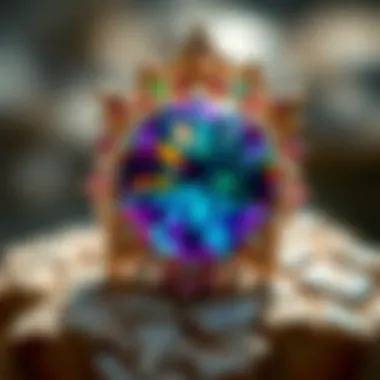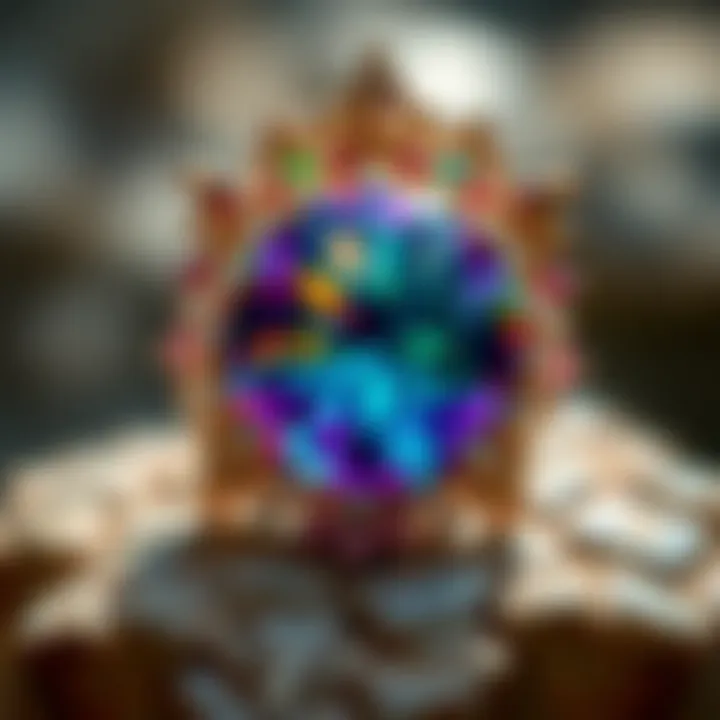A Guide to Gemstone Colors and Their Significance


Intro
The world of gemstones is a vast tapestry of colours and meanings, a realm where nature’s artistry is on full display. Each stone tells a story through its colour, crafted by the geological conditions under which it formed. To aficionados and newcomers alike, understanding these hues can elevate one’s appreciation from mere admiration to a richer comprehension of their unique beauty.
Gemstones are not just attractive pieces; they are also reflections of the planet’s history and the cultures that have revered them. From ancient civilizations that adorned themselves with these mineral marvels to today’s collectors who seek them for their aesthetic and economic value, gemstones stand as a bridge between natural science and artistic expression.
In this guide, we will unearth the layers of significance behind various gemstone colours and names. We will explore how mineral compositions and the historical contexts of these stones contribute to their allure—not just in vernacular but also in cultural appreciation and value in markets.
Rock and Fossil Identification
Considering the premise of gemstones, it's essential to first understand their parent material—rocks. Though they may seem starkly different, the study of rocks enhances understanding of gemstones. Identifying rocks can involve recognizing various types and understanding their characteristics, which can also shape one’s insight into gemstones.
Types of Rocks and Fossils
There are three primary types that one might come across:
- Igneous: Formed from cooled molten rock, these include granite and basalt.
- Sedimentary: Created from mineral and organic particles, examples include limestone and sandstone.
- Metamorphic: Rocks altered by heat and pressure, such as marble and schist.
Fossils, typically found within sedimentary rocks, encapsulate the remnants of historical lifeforms—from ancient insects encased in amber to shell imprints in limestone.
Characteristics to Look For
When identifying rocks and fossils, pay attention to:
- Texture: The feel of the rock can be a clue; is it smooth, rough, or glassy?
- Colour: Shades can indicate mineral presence—iron gives reds and oranges, while copper can lend a greenish hue.
- Hardness: Use the Mohs scale to test its scratch resistance.
- Structure: The arrangement of crystals or layers can tell a story about the formation process.
Tools for Identification
To aid in identification, it is wise to equip oneself with certain tools. Here are some essentials:
- Hand lens: Helps in examining finer details and textures.
- Field guide: Reference books tailored to geology can provide context and imagery.
- Mohs hardness kit: Useful for testing the rock's durability.
Collecting Tips and Techniques
Whether you are a seasoned collector or just curious, there are techniques that can enhance your experience in accumulating both precious and common stones. Below are some strategies for successful collecting.
Best Practices for Collecting
- Always obtain permission if collecting in private land.
- Follow regulations when mining or gathering in public areas.
- Be mindful of the environment; do not disturb habitats.
Locating Prime Collecting Sites
Some sought-after areas where one might find a treasure trove of minerals includes:
- National parks—check guidelines first.
- Near volcanic regions, where igneous rocks abound.
- Sites with a history of mining, often yielding gems and other minerals.
How to Safely Extract Specimens
Extraction strategies could vary, but ensuring safety is paramount:
- Use gloves to protect against sharp edges.
- Bring tools like chisels and hammers for proper extraction, but do so sensitively.
Preservation and Display
After collection, how one displays and preserves their finds speaks volumes about their value and care.
Techniques for Preserving Rocks and Fossils
- Clean specimens gently with water, avoiding harsh chemicals that can damage.
- Store them in a dry place to avoid moisture damage.
- For fossils, consider using a sealant to preserve delicate features.
Proper Storage Methods
- Use padded boxes: Provide insulation during transport and storage.
- Label specimens: Keep records of where and when they were collected.
Creative Display Ideas
A well-presented collection can be a conversation starter:
- Utilize shadow boxes to create visual interest.
- Arrange by colour or type for aesthetic appeal.
Geological Insights
Understanding the geological processes that result in various gemstones enriches the experience of collecting and appreciating them.
Geological Formations and Processes
- Plate tectonics: Movement of the Earth’s plates can lead to the creation of mineral deposits.
- Weathering and erosion: Affects how gemstones are retrieved from the Earth.
Historical Significance of Rocks and Fossils
Rocks and fossils are time capsules. For example, the study of fossils gives insight into past climates and ecosystems.
Notable Discoveries in the Field
Discoveries such as the largest diamond, the Cullinan, or the famous fossilized remains of the woolly mammoth have significant historical importance. Each discovery adds to the narrative of how the world has changed over millennia.
Each gemstone is akin to a page in Earth’s history book, encapsulating stories of art, culture, and geology.
In navigating through the various colours and names of gemstones, one realizes they are not mere decorative items; they are storytelling devices, bridging deep-rooted historical contexts with modern-day appreciation.
For more information on gemstones, you can visit Wikipedia or Britannica. You may also find communities of enthusiasts on platforms like Reddit where advice, stories, and insights are shared.


Intro to Gemstone Colours
The study of gemstone colours is more than just eye-catching hues; it's an exploration of beauty intertwined with science and culture. In this guide, we aim to peel back the layers of understanding about what gives gemstones their distinctive shades and why these colours resonate so deeply. Even more, the way these stones capture the light and interplay with different elements of nature reflects not only their physical properties but also their significance across various cultures and epochs.
Understanding gemstone colours sets the foundation for enthusiasts, collectors, and scholars alike. It can enhance one’s appreciation of these natural beauties, whether you're displaying them in a collection or wearing them as jewelry. The sheer variety of colours available within gemstones is staggering; from the deep blues of sapphires to the vibrant reds of rubies, each hue tells its own story.
In this introductory section, we’ll go into the basics of how colours manifest in gemstones, explore their significance in identification, and set the stage for a deeper understanding of the inherent beauty and value these stones bring to our lives.
Understanding the Basics of Gemstone Colour
At its core, the colour of a gemstone results from the interplay of various factors: its chemical composition, the way light interacts with it, and even its physical structure. Gemstones can display a spectrum of shades and tones, which are affected by the presence of trace elements. For instance, the deep blue of a sapphire comes from the inclusion of iron and titanium, while the rich green of an emerald is a product of chromium's influence.
Moreover, the categorization of colour into hue, tone, and saturation is crucial for any stone enthusiast.
- Hue is the base colour of the stone – for example, red, blue, or green.
- Tone describes how light or dark a colour appears, ranging from light to dark.
- Saturation refers to the intensity of the colour, where a highly saturated stone appears more vivid compared to a desaturated one.
Understanding these aspects helps collectors and gemologists identify and appraise gemstones more effectively.
The Importance of Colour in Gemstone Identification
Colour is not just an aesthetic trait; it serves as one of the most reliable indicators in identifying gemstones. Often, it's the first thing that draws a person’s attention, making it a primary factor in classification. Experienced collectors often hone their skills by recognizing colours and understanding what specific hues might indicate regarding a stone's provenance, treatment, or value.
A vibrant red might signify a high-quality ruby, while a muted version could suggest that it's a different, less valuable type, such as a garnet. This principle underscores the importance of learning about gemstone colours; to the untrained eye, subtle differences may go unnoticed, but for a stone expert, those variations can change everything.
"In the world of gemstones, colour is king, guiding collectors and gemologists alike in their quest for beauty and authenticity."
As we traverse this guide, we will expand on these concepts and explore each gemstone's unique colour classification, enhancing your appreciation and understanding in every way.
Classification of Gemstone Colours
Understanding gemstone colours is crucial for anyone interested in the beauty and intricacy of these natural wonders. The classification of colours serves as a foundation for identifying gems, evaluating their quality, and appreciating their unique characteristics. Each gemstone possesses a specific colour or range of colours that can provide insights into its origin, composition, and even value. Without a structured approach to colour classification, the diverse hues of gemstones could easily overwhelm even the most seasoned collector.
When it comes to the classification itself, there are a few key elements that play a vital role. This includes hue, tone, and saturation, each of which contributes to the overall perception of colour. Understanding these elements isn’t just for academics or gemologists; it equips collectors with the tools to make informed choices, whether they're shelling out for a prized specimen or adding to their gemstone jewellery.
The Role of Hue, Tone, and Saturation
Hue refers to the basic colour of the gemstone, such as red, blue, or green. However, hue alone doesn't tell the whole story. It’s essential to consider the tone, which describes how light or dark a colour is. A ruby could range from a light pinkish-red to a deep, blood-red, and both hues are defined by their tone. Saturation measures the intensity or purity of a colour. For instance, a vibrant, pure blue sapphire stands apart from one that leans toward a gray or greenish tint.
- Hue: The identifiable component of colour (e.g., red, blue, yellow).
- Tone: How light or dark that colour appears.
- Saturation: The vividness of the colour, indicating clarity versus muddiness.
When gemologists discuss colour in their evaluations, these three attributes must fit together harmoniously. A high-quality gemstone may exhibit strong hue, medium tone, and high saturation, meaning it possesses that vividness and clarity desired in high-value gems.
The combined assessment of hue, tone, and saturation serves as a critical toolkit for anyone looking to delve into the world of gemstone collecting or trading.
Common Colour Classifications Used in Gemology
Gemology employs several methods to classify colours, with some commonly used terminologies that can make the learning process smoother.
- Natural Colours: These are colours found in gemstones as they occur naturally. For example, emeralds are typically green because of chromium or vanadium content.
- Synthetic Colours: These are lab-created stones that mimic the appearance of natural stones but may display more intense colours without imperfections.
- Fancy Colours: This term applies to diamonds that appear in a wide range of hues including yellow, pink, or blue. Each fancy colour can be further classified based on hue, tone, and saturation.
- Colour Zoning: Some gemstones might exhibit multiple colours within the same stone, known as colour zoning. Understanding this aspect can help collectors assess how the colours interplay and how they influence value.
"The true beauty of a gemstone lies in the subtleties of its colour – learning to see, appreciate, and categorize these nuances opens a whole new world for collectors."
For those passionate about gemstones, these classifications not only enrich their understanding but also enhance their appreciation. The color spectrum in gemstones is vast and varied, making every collection unique, reflecting personal tastes and stories as well.
Primary Gemstone Colours
The notion of primary gemstone colours serves as a cornerstone in our quest to understand not just the allure of gemstones but also their significance in culture and commerce. Each primary colour evokes distinct emotions, associations, and values. When we break down the wide spectrum of gemstones, we see that their primary colours—red, blue, and green—hold a unique place in their classification and appreciation.
Red Gemstones: Fire and Passion
Rubies
Rubies, often deemed the "king of gemstones," are adored for their vibrant red hues, a colour that often symbolizes power and wealth. Their most notable aspect lies in their striking saturation, which captures the light beautifully. Rubies are a popular choice not only for their beauty but also for their durability; they rank 9 on the Mohs hardness scale, making them suitable for everyday wear. Their unique feature is the phenomenon of asterism, which is the appearance of a star-like pattern on the gem, a rare quality that enhances their desirability. However, this complexity in quality may pose a challenge for collectors, as one must be well-informed to avoid imitations or treated stones.
Garnets
Garnets present a wide variety of red tones ranging from deep burgundy to bright crimson, making them versatile in the world of jewelry design. They are valued for their affordability compared to rubies, offering striking beauty without breaking the bank. They possess a unique feature called pleochroism, where the stone can display different colours when viewed from different angles, adding an element of surprise for the wearers. Despite that, the softness of garnets, ranking around 6.5 to 7.5 on the Mohs scale, might limit their use in certain settings, especially in rings that endure everyday wear.
Blue Gemstones: Tranquility and Depth
Sapphires
Sapphires are synonymous with success and loyalty, representing divine favor across cultures. Their key characteristic—the range of blue from the deepest navy to the lightest sky shade—appeals to many. They are generally a beneficial choice in terms of investment since high-quality sapphires can command significant prices, especially if they're untreated. A unique property of sapphires is the ability to display colour-change phenomena when viewed in different kinds of light—a curiosity that often fascinates collectors. However, discerning the quality of sapphires requires keen eyes as stones can often be artificially enhanced.
Topaz
Topaz brings a gentle yet striking pastel blue to the gemstone arena. This colour is visually appealing, providing a softer alternative to sapphires. Topaz's slight transparency allows light to filter through, creating a sparkling effect that captures the imagination. They’re also remarkably affordable compared to sapphires, appealing to collectors and casual buyers alike. However, careful attention should be given to the potential for treatments. Many topaz stones undergo heat treatment to enhance their colour, and knowing this fact can impact their value.
Green Gemstones: Nature and Renewal
Emeralds
Emeralds are rich in history and folklore, often associated with rebirth and spring. Their key characteristic, the deep green colour, is a product of chromium and vanadium content, making them unique among gemstones. They rank just debajo of sapphires and rubies in terms of desirability due to their spectacular colour and historical significance. For collectors, their common inclusions, known as "jardin," which is a hallmark of authenticity, can be both an advantage in terms of uniqueness and a disadvantage in terms of fragility. The softness of emeralds, compared to other primary gemstones, raises discussions about everyday practicality versus show-stopping aesthetics.
Peridots
Peridots bring a lively olive green hue to the collection of green gemstones, often regarded as symbols of prosperity and revitalization. Their uniqueness lies in the manner in which they reflect light, often exhibiting a slight golden shimmer. This gemstone is more affordable than emeralds, making them an attractive option for those just diving into gemstone collection. However, the fact that peridots are softer, ranking around 6.5 to 7 on the Mohs scale, signals wearers to handle them with care to preserve their beauty.
Each primary colour of gemstone tells a captivating story, inviting collectors and enthusiasts to delve deeper into the magical world they inhabit.
Secondary Gemstone Colours
Secondary gemstone colours play a significant role in the wider narrative of gemology. While primary hues carry a certain grandeur and are often the headline act in the gemstone world, secondary colours add layers of complexity to the visual appeal of these natural treasures. They invite a connoisseur's eye, capable of discerning subtleties that may escape a casual observer. This section will shine a light on the remarkable purple, yellow, orange, and pink gemstones that often find themselves in the shadows of their more celebrated counterparts.


Purple Gemstones: Luxury and Royalty
Purple gemstones are often associated with nobility and spirituality. Their deep, rich hues can evoke feelings of luxury and extravagance. In this subset, we will examine two notable examples, amethysts and purple spinels, both of which boast unique characteristics that elevate their status in the gem collector’s treasure chest.
Amethysts
Amethysts stand out for their striking violet hue, which varies based on light exposure and the specific locality from where they are sourced. The most notable aspect of amethysts is their historical significance, as they were once considered more precious than diamonds. Today, they are more accessible, making them a popular choice among collectors.
One key characteristic that makes amethysts attractive is their versatility. They can be found in various cuts and settings, adapting well to diverse styles, from vintage to modern jewelry. This allows them to appeal to a wide audience.
"Amethysts are not just stones; they represent history, spirituality, and an undeniable elegance that captures the essence of luxury."
However, one disadvantage is that amethyst is relatively common when compared to some rarer gems. This abundance can sometimes diminish its perceived value among collectors seeking one-of-a-kind pieces. Still, the depth of color and ease of availability make it a staple for both novice and experienced collectors alike.
Purple Spinel
On the other hand, purple spinel is a lesser-known gem, yet it makes waves with its remarkable durability and vivid colors. Known for their sparkly brilliance, these stones come in shades ranging from light lavender to deep royal purple, allowing for various visual experiences based on light and cut.
Purple spinel often gets overshadowed by amethyst but brings its own benefits to the table. Its hardness on the Mohs scale makes it less prone to scratching, which is advantageous for everyday wear.
Despite being lesser-known, purple spinel holds a certain allure for informed collectors. Its unique feature incorporates phenomenal displays of color change in certain lighting conditions, making it an exceptional choice for those who appreciate the intricacies of gemstone allure.
Yellow and Orange Gemstones: Bright Energy
Yellow and orange gemstones burst with vibrancy, signifying energy and creativity. These stones can elevate any collection, and we'll zoom in on citrine and orange sapphires to explore their unique offerings.
Citrine
Citrine, known as the "merchant's stone", is famed for its warm yellow to orangish hues. One of the most appealing aspects of citrine is its affordability, especially when compared to other yellow gems like yellow diamonds. It possesses a cheerful disposition that can add a dash of sunshine to any jewelry piece, making it particularly favored in the fashion realm.
However, while citrine is accessible, genuine citrine can be hard to distinguish from heat-treated amethyst. This overlap can sometimes mislead buyers. Yet, its bold presence can’t be disregarded, as it brings a fresh, optimistic feel to both casual and formal wear.
Orange Sapphires
Orange sapphires, often termed "padparadscha sapphires", are another captivating addition to this category. These gems boast a stunning blend of pink and yellow undertones, presenting a unique palette that catches the eye. The rarity of orange sapphires significantly boosts their desirability among collectors, making them a sought-after gemstone with considerable investment potential.
While their beauty is undeniable, the price can be quite steep, especially for higher-quality stones. This makes them more of an investment compared to their yellow counterparts. Still, the vibrancy and uniqueness of orange sapphires certainly make them enticing for those looking to differentiate their collections.
Pink Gemstones: Romance and Charm
Pink gemstones, often linked to love and tenderness, add a certain charm to any collection. Their various shades invite admiration, and in this section, we’ll focus on pink diamonds and pink tourmaline.
Pink Diamonds
Pink diamonds are a rare phenomenon in the gemstone world, characterized by their light to dark tones. Their rarity contributes to an astonishing market demand that is likely to appreciate over time. One key aspect that distinguishes pink diamonds is the mesmerizing way their color can change, depending on the light angle. This dynamic visual appeal is a strong reason collectors seek them.
Nevertheless, their high price point can be a barrier for many. This exclusivity might not suit every collector’s budget, but for those who can afford them, pink diamonds represent an investment and a piece of history and nature in one stunning package.
Pink Tourmaline
Pink tourmaline offers a more attainable alternative to pink diamonds while still carrying a strong romantic appeal. Available in shades ranging from soft pastel to vibrant fuchsia, pink tourmaline is celebrated for its unique dual-toned possibilities. Many prefer this gem for its affordability and versatility in jewelry designs.
Despite their beauty, pink tourmaline can sometimes have inclusions that affect clarity. While this trait might deter some serious collectors, many appreciate the natural character these inclusions provide, celebrating each stone’s individuality. The vibrant energy of pink tourmaline makes it a beloved choice, especially for those crafting their own collections with a focus on personal expression.
In summary, secondary gemstone colours reveal not just a spectrum of beauty but also the stories tied to each stone, illuminating the rich history and complex appeal they bring to collectors and enthusiasts. By understanding these gems, one can construct a collection that reflects both aesthetic preferences and elements of search for rarity and value.
Rare and Uncommon Gemstone Colours
In the realm of gemstones, the fascination doesn't stop at the usual spectrum of colours. The rare and uncommon hues often evoke curiosity, intrigue and appeal to those with a discerning taste. These stones not only serve as unique collectibles, but they also tell stories of Earth's history and geological processes. Exploring these peculiar colours reveals much about their formation and the underlying conditions that make them so distinctive.
Uncommon gemstones have the added advantage of being conversation starters. Imagine holding a rare gemstone that almost no one else owns; it serves not just as jewelry but as a slice of the Earth's artistry. Black diamonds and smoky quartz, for example, both carry with them stories of their origins, while their rare colours make them sought after by collectors. Such stones often come with a price tag that reflects their novelty, and knowing about them can help collectors make informed decisions about their purchases and investments.
Black Gemstones: Mystery and Strength
Black Diamonds
Black diamonds are an intriguing category of gemstones. Unlike the traditional clear diamonds that glimmer with light, black diamonds exhibit a certain mystique, a heftiness that’s not just for show. The unique characteristic of these stones comes from their many inclusions, which absorb rather than reflect light. This gives them a fascinating appearance, making them stand out in the world of precious stones.
Collectors often gravitate towards black diamonds due to their rarity and distinctive look. Their durability makes them a practical choice for jewelry that stands the test of time. Yet, it's worth noting that some people have concerns about the overall "value" of black diamonds compared to their transparent counterparts; perceived luxury can vary from one buyer to another. However, black diamonds certainly offer a bold statement in any piece of jewelry.
"Black gemstones symbolize strength, mystery, and an appreciation for the unique aspects of nature."
Onyx
Onyx adds another layer to the discussion of black gemstones. Known for its rich black colour and smooth texture, onyx carries a serene quality that resonates with many collectors. Not just a pretty face, it is seen as a protective stone in various cultures. This belief adds depth to its value, making it not only aesthetically pleasing but also meaningful.
A significant advantage of onyx lies in its versatility; it can be crafted into various forms, from cabochons to beads. Additionally, it often comes at a lower price point compared to black diamonds, making it accessible for a wider range of collectors. However, the question arises whether it holds the same artistic merit as rarer stones. This often comes down to personal preference and what a collector is hoping to achieve in their collection.
Brown Gemstones: Earthy Elegance
Brown Zircon
Brown zircon is another captivating choice for collectors interested in uncommon colours. Often overshadowed by its blue counterpart, brown zircon carries a warm earthiness that holds appeal. The key characteristic of brown zircon is its brilliance and fire, which can rival many diamonds. Its unique feat is that it is a natural gemstone that is equally versatile in use.
Collectors may find brown zircon advantageous, not just for aesthetic reasons, but also for its relative affordability. The historic value tied to the gemstone, often associated with youth and renewal, makes it particularly appealing. On the flip side, the rarity of certain shades can make it more challenging to find. That said, owning a piece of brown zircon can easily elevate one's collection.
Smoky Quartz


Smoky quartz completes this section on brown gemstones. Its distinctive smoky hue provides a level of calmness and grounding, making it desirable for both jewelry and collector pieces. Its earthy elegance is characterized by rich tones that vary from light to dark shades of brown. Unlike many rare stones, smoky quartz is relatively widely available.
The key benefit of smoky quartz lies in its accessibility, allowing more collectors to incorporate this lovely stone into their collections. However, the abundance may also dilute its perceived value, making it crucial for collectors to focus on quality over quantity. As with all gems, appreciation for smoky quartz often boils down to the stories they tell and the personal significance they hold for their owners.
The Influence of Geological Conditions on Gemstone Colour
Understanding how geological conditions shape gemstone colours opens a fascinating window into the natural world. Each gemstone's hue is influenced not just by the minerals present, but also by the geochemical environment in which it forms. As a gemstone enthusiast or a collector keen on expanding your knowledge, grasping these concepts can vastly enhance your appreciation of each unique stone.
How Mineral Composition Affects Colour
The core of a gemstone's colour often lies within its mineral composition. Take, for instance, the widely admired sapphire. This gemstone, predominantly composed of aluminum oxide, can feature an array of hues owing to tiny traces of various elements. When iron and titanium are present during its formation, those beautiful blue tones emerge.
Conversely, the rich green tones of an emerald are a result of the presence of chromium and sometimes vanadium within a beryl matrix. The more pronounced the concentration of these elements, the more vibrant the resulting colour. It's almost like a delicate balancing act where too much or too little of these minerals can alter the final outcome drastically.
"The minerals make the magic happen. It’s like a master artist mixing paints on a palette to create a masterpiece."
Moreover, some gemstones can exhibit pleochroism—a remarkable phenomenon where a stone appears to change colour when viewed from different angles due to differing light absorption, a direct consequence of its mineral makeup. A prime example is the iolite, which can show a lovely violet-blue from one angle and a clear yellowish hue from another. Collectors often cherish these complexities, making them more intriguing.
Environmental Factors That Determine Gemstone Colour
Beyond the minerals, environmental factors play a pivotal role in determining the colour of gemstones. Pressure, temperature, and the overall geological setting significantly influence how gemstones form. High-pressure conditions, like those found deep within the Earth, are often responsible for the creation of exquisite diamonds. The extreme heat and pressure significantly impact the crystalline structure and, consequently, the colour of the stone.
Additionally, variations in temperature can lead to changes in colour within the same mineral species. Tourmaline, for example, can display an array of colours from pink to green in a single crystal, which is often referred to as watermelon tourmaline. This colour zoning is often due to changes in the temperature and compositions of the environment during its formation.
Other factors include the presence of fluids in the geologic environment, which can introduce additional elements that alter the colour. For instance, if quartz crystallizes in an iron-rich environment, it may develop a striking smoky hue, whereas in a clear, low-iron setting, it retains its classic transparent appearance.
Understanding these influences is not just for academic purists; it's practical knowledge for collectors to ensure they appreciate the unique narratives each gemstone holds. The colours of these stones are as much a story of their past as they are elements of beauty.
Cultural Significance of Gemstone Colours
Understanding the cultural significance of gemstone colours goes beyond aesthetics; it delves into history, tradition, and human psychology. Humans have always been captivated by stones, attaching meanings to colours that reflect our emotions, aspirations, and values. Different cultures ascribe various meanings to specific hues, influencing everything from jewelry design to art and storytelling. In our exploration of gemstone colours, it is vital to recognize these interpretations, as they profoundly impact how gemstones are valued and perceived in various societies.
Gemstones are not merely beautiful objects. They're narratives woven from the fabric of human experience, embodying dreams, beliefs, and cultural identities. People often choose gemstones based on their colour significance, which can also shape trends in both contemporary and historical contexts. Listed below are some notable aspects that highlight the importance of understanding cultural perspectives on gemstone colours:
- Influence on Choices: People often select gemstones for their symbolism. For instance, couples might opt for sapphires for engagement rings, associating them with wisdom and loyalty.
- Cultural Traditions: Various cultures celebrate different colours. For example, red is often associated with love and good fortune in many Asian cultures and is highly prized in wedding jewelry.
- Historical Impact: Ancient civilizations, like Egypt and Mesopotamia, regarded certain gemstones as sacred, using them in ceremonies and burial rites, often believing they held the power to protect the spirit in the afterlife.
As the world evolves, so do interpretations of these colours, increasingly influencing the market and collection trends among gem enthusiasts. It's therefore essential to appreciate how the cultural backstory of a gemstone can elevate its value and desirability.
Historical Perspectives on Colour Associations
Going back to ancient times, gemstones were not just ornaments but were laden with symbolic meanings and associations. The history of colour associations is rich and varied. Ancient cultures designated various colours with specific traits, imbuing them with meaning that transcended their visual appeal.
For instance, in ancient Rome, purple was a colour of power and aristocracy, often seen in royal garments. Thus, amethysts, which showcase a deep purple hue, were coveted by emperors who believed the stone would protect them amid turmoil. Similarly, in many indigenous cultures around the globe, colours were linked to the elements and nature. Turquoise, with its blue-green shades, was revered by Native Americans as a stone of protection and healing.
Moreover, the medicinal and mystical properties attributed to colours and gemstones have persisted through centuries. The colour red has historically represented vitality and life force, most notably through red garnets, while sapphires were linked to divine favor and insight in the Middle Ages. In these historical frameworks, gemstones adapted to reflect societal values and evolving beliefs about nature and spirituality.
"Gemstones, with their unique hues, serve as a bridge connecting the natural world to cultural meanings, reminding us that beauty is often intertwined with belief."
Modern Interpretations and Symbolism of Gemstone Hues
As we advance into the contemporary era, the interpretations of gemstone colours have evolved, merging traditional views with modern sensibilities. Today’s society frequently associates colours with emotions and personal expression. This paradigm has led to rising popularity in custom jewelry, where individuals select stones based on their significance in contemporary contexts.
For example, the colour blue now often symbolizes calmness and clarity, making aquamarine a favourite among those wishing to cultivate serenity in their lives. Green gemstones, particularly emeralds, often align with concepts of growth and renewal, appealing to those pursuing personal development or embarking on new journeys.
Additionally, social movements and cultural shifts continue to shape interpretations of colours. The rise of mindfulness and emotional intelligence has highlighted the importance of colours in emotional well-being, amplifying the desire for gemstones perceived to radiate positive energy. Collectors and enthusiasts are not just looking for stunning visuals but are also seeking stones that resonate with their values and life experiences.
Sometimes, gemstones show a blend of interpretations. A pink tourmaline can symbolize both love and healing, catering to a wide spectrum of sentiments from romance to personal growth. In this modern landscape, the way we perceive colours takes on multiple layers, reflecting deeper meanings and cultural narratives.
In summary, the cultural significance of gemstone colours invites us into an intricate world where colours tell stories, evoke feelings, and bind us together, transcending time and space.
Collecting Gemstones Based on Colour
The vibrant spectrum of gemstone colours goes beyond mere aesthetics; it's a foundational element in the collecting world. For enthusiasts and collectors alike, building a collection based on colour can transform one’s acquisition journey into a colorful narrative rich with cultural significance, emotional attachment and potential monetary value. By focusing on hues, collectors can not only showcase their preferences but also reflect the numerous unique attributes gemstones exhibit.
Examples abound where specific shades have spurred tremendous interest. Think of collectors in search of rare pink diamonds or those fascinated by the deep green of known emeralds. This practice fosters appreciation for the diverse possibilities that gemstones offer, enticing collectors to delve deeper into the science of colours, while also educating themselves about the underlying geological factors that influence these shades.
"Collecting gemstones based on colour is like curating a visual experience that resonates with both personal taste and broader cultural narratives."
Strategies for Building a Colour-Focused Collection
When it comes to building a colour-focused gemstone collection, strategic thinking can yield significant benefits. First, defining a core theme becomes vital: is it a specific colour, such as blue, or perhaps a blend of hues within a specific family? Here are a few strategies to consider:
- Research and Knowledge: Dive into books, articles, or reputable websites dedicated to gemology to understand how gemstone colours are classified and perceived. Websites such as GemSelect or GIA provide rich resources.
- Specialize and Diversify: While it can be exciting to focus solely on one colour, sometimes blending shades can enhance the overall visual impact of a collection. For example, combining a vibrant red garnet with a more subtle pink tourmaline can result in a stunning display.
- Curation of Quality: Depending on budget, prioritize quality stones rather than quantity. A few well-chosen pieces can make a more significant impact than a collection crowded with mediocre specimens.
- Attend Gem Shows and Auctions: Networking with fellow collectors or vendors at trade shows such as the Tucson Gem and Mineral Show opens doors to unique finds that may not be available elsewhere.
Considering Market Trends and Values
Understanding market trends is crucial for any gemstone collector, especially when focusing on colour. Different hues fluctuate in value based on demand, rarity, and current market interest. Recently, bright pinks and intense blues have seen new price highs, while others, like common brown stones, may be less sought after.
- Regular Market Checks: Keeping an eye on auction results, sale prices, and collector forums, including platforms like Reddit, can provide insight into which colours are trending up or down.
- Engagement in Online Communities: Joining online groups on platforms like Facebook helps engage with other collectors who share insights and market analyses. Members often share tips on pricing and potential investment gems.
- Buy with Intent: As you build your collection, consider potential resale value, especially in jewel tones or rarer colours. Just like coins or stamps, certain colours can appreciate over time, influenced by changing tastes and emerging trends.
By embracing these principles, collectors can enjoy the enriching experience of gemstone acquisition in a way that’s both aesthetic and financially rewarding.
Closure: The Lasting Allure of Gemstone Colours
The world of gemstones is not just about their fascinating hues but also the stories they tell and the emotions they evoke. This article underscores the intricate dance between geology and artistry, revealing how a mere glimmer can capture the human spirit. As we explored the kaleidoscope of colours, it became clear that each shade can carry profound significance, whether deeply rooted in culture, history, or personal expression.
Gemstone colours are not just a matter of aesthetics. They can symbolize sentiments—think of a vibrant red ruby that signifies love or the serene blue of a sapphire representing wisdom. In the hands of collectors and enthusiasts, these stones transcend their physical properties; they become repositories of cultural identity and personal meaning. The choice of a gemstone may mirror one's aspirations, memories, or even subtle nuances of life itself.
Moreover, the geological processes behind these splendid colours remind us of the Earth's magnificence. Conditions such as temperature, pressure, and mineral presence shape these crystals into the stunning gems we admire today. Mining operations in places like Brazil or Myanmar typically yield materials that bring forth colours practically impossible to replicate synthetically. This rarity adds an undercurrent of exclusivity to gemstones, heightening their desirability.
As you journey through the captivating landscape of gemstone collecting, consider the lasting allure that these stones hold. Here are some key points worth reflecting on:
- Cultural Significance: Gemstones have been intertwined with human culture for centuries, often serving as symbols of power, love, and legacy.
- Emotional Connection: The colour of a gemstone can resonate with an individual's emotional landscape, providing personal significance.
- Investment Potential: Understanding gemstone colours helps collectors make informed choices, potentially leading to wise investments over time.
In summary, the allure of gemstone colours extends far beyond their visual beauty. These striking shades offer a glimpse into Earth's history, intertwine with human experience, and present opportunities for personal expression and investment. As collectors delve deeper into this colourful domain, they find not just stones but stories—an everlasting connection to the cosmos encapsulated within each exquisite gem.
"Gemstones are not just reflections of light. They are whispers of Earth’s history, and echoes of our shared human experience."
To dive deeper into this enchanting realm, resources such as Wikipedia, Britannica, and discussions on platforms like Reddit can provide further insights into the myriad hues and meanings behind gemstones.







